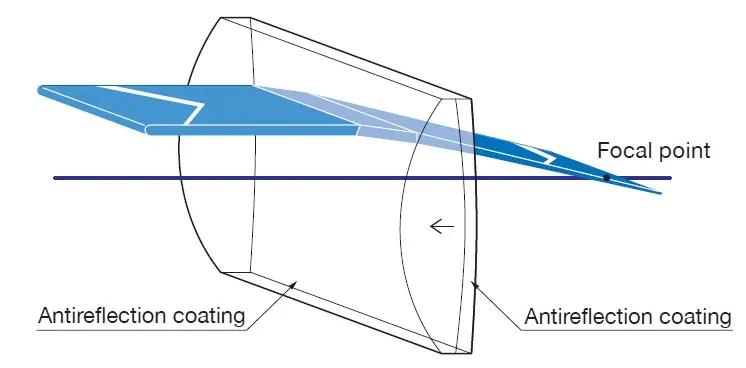A cylindrical optical lens is typically used to focus, condense or expand incoming light. A cylindrical lens has one cylindrical surface, causing light to be focussed in a single dimension or axis. It can also be used to expand the output of a laser diode into a symmetrical beam. Cylinder lenses are technically more difficult to manufacture than spherical or flat lenses which is why Ecoptik uses state-of-the-art polishing techniques alongside stringent lens assessment to manufacture each lens.
A cylindrical optical lens is typically rectangular, square, or circular and of either a plano-convex or plano-concave design. The cylindrical optical lenses of Ecoptik combine low wedge with high surface accuracy. As a leading optical components manufacturer, we assess the quality of each individual lens using Trioptics centration measurement and a Zygo GPI interferometer. All Ecoptik lenses are available both uncoated or coated with a broad range of high durability, low loss AR coatings, and can be manufactured to 20-10 surface roughness.
Optical cylindrical lens can be used for converging or diverging light beams in a single axis. Cylindrical lens is used in many industries and fields such as optical metrology, laser scanning, spectroscopy, laser diode output beam shaping, and light-sheet illumination microscopic imaging.
Form the collimated light source into a line light source
This is the most wide use of cylindrical lens. Taking a plano concave cylindrical lens as an example, it can be a beam of collimated light that expands into a linear light source according to the magnification.
The cylindrical lens is also used for astigmatism. Collimation of diode output beam The output beam of the laser diode diverges in an asymmetrical form, and its collimation work is more challenging. For example, for a diode light source with a divergence angle, if only a standard spherical lens is used, it can only be collimated in a single direction, and divergence or convergence will occur in the other direction. Using cylindrical mirrors can decompose the problem into two one-dimensional directions. By combining two orthogonal cylindrical mirrors, the two directions can be collimated simultaneously.
Optical Cylindrical Lens, mainly used to change the size of the imaging design requirements. Such as converting a spot to a line spot or changing the height of the image without changing the width of the image. Cylindrical lens has special optical properties. With the rapid development of high technology, cylindrical lens is used more and more widely.
Such as line aggregation system, film camera system, fax machine and scanning imaging system of printing and typesetting, gastroscopy and laparoscopy in the medical field, vehicle video system in the automotive field with the participation of cylinder mirror. Also in linear detector lighting, barcode scanning, holographic lighting, light information processing, computer, laser emission. It is also widely used in strong laser system and synchrotron radiation beam line.
At the same time, with the continuous improvement of cylindrical lens processing technology, a mature and efficient processing technology has been formed, and its good quality reproducibility and repeatability are gradually recognized by the market. At present, the technology is gradually replacing the relatively backward traditional technology.

Commercial High precision | |
Material | Optical glasses, fused silica, silica, etc. |
Diameter | 0.5mm ~ 150mm |
Diameter tolerance | ±0.1mm ±0.02 |
Focal length | -50mm ~ 2000mm |
Focal length tolerance | ±2% (<10mm) ±0.5%<10mm – 1000mm) ±1% (>1000%) |
Centration | <3 arc min <10 arc sec |
Clear aperture | >85% ~92% of diameter |
Surface quality | ( Scratch / Dig) MIL 60/40 MIL 10/5 |
Surface accuracy | λ/4@632.8nm λ/10632.8nm |
Bevel | 0.05mm~0.2mm x 45° |
Coating | According to customer’s requirement |
Spherical lenses are lenses taken out from a sphere such as a ball. Where as, cylindrical lenses are lenses taken out from a surface of a cylinder like a tumbler. Cylindrical lenses have an axis associated with them. Both, spherical and cylindrical power can keep changing through life.
A cylindrical lens is typically used to focus, condense or expand incoming light. A cylindrical lens has one cylindrical surface, causing light to be focussed in a single dimension or axis. It can also be used to expand the output of a laser diode into a symmetrical beam.
We have zygo and professional lens cylinder inspection system, and can provide a full set of inspection reports.
According to the quantity of the customer's order and the requirements of the lens index, the appropriate processing technology is selected. There are two types of classical processing methods and high-polishing processing methods.